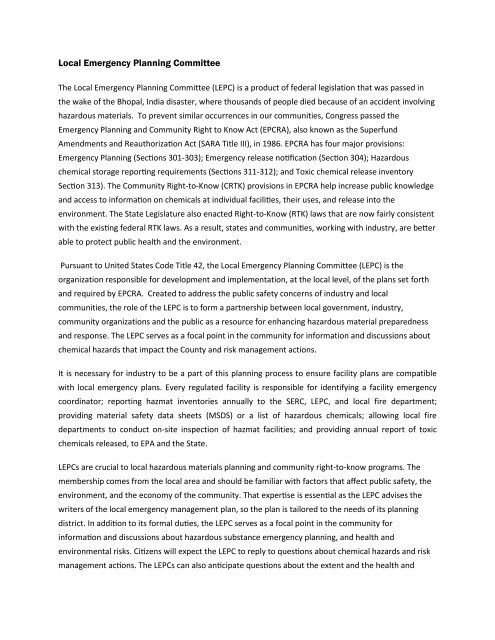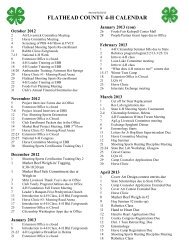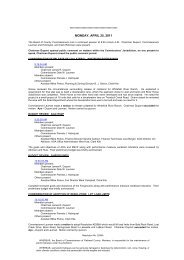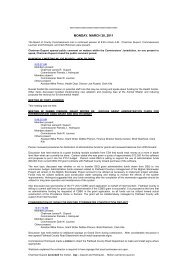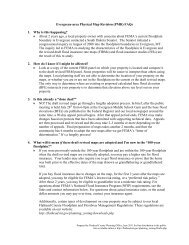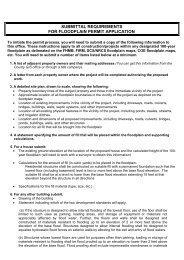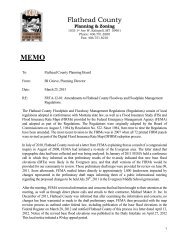LEPC Bylaws - Flathead County, Montana
LEPC Bylaws - Flathead County, Montana
LEPC Bylaws - Flathead County, Montana
Create successful ePaper yourself
Turn your PDF publications into a flip-book with our unique Google optimized e-Paper software.
Local Emergency Planning Committee<br />
The Local Emergency Planning Committee (<strong>LEPC</strong>) is a product of federal legislation that was passed in<br />
the wake of the Bhopal, India disaster, where thousands of people died because of an accident involving<br />
hazardous materials. To prevent similar occurrences in our communities, Congress passed the<br />
Emergency Planning and Community Right to Know Act (EPCRA), also known as the Superfund<br />
Amendments and Reauthorization Act (SARA Title III), in 1986. EPCRA has four major provisions:<br />
Emergency Planning (Sections 301-303); Emergency release notification (Section 304); Hazardous<br />
chemical storage reporting requirements (Sections 311-312); and Toxic chemical release inventory<br />
Section 313). The Community Right-to-Know (CRTK) provisions in EPCRA help increase public knowledge<br />
and access to information on chemicals at individual facilities, their uses, and release into the<br />
environment. The State Legislature also enacted Right-to-Know (RTK) laws that are now fairly consistent<br />
with the existing federal RTK laws. As a result, states and communities, working with industry, are better<br />
able to protect public health and the environment.<br />
Pursuant to United States Code Title 42, the Local Emergency Planning Committee (<strong>LEPC</strong>) is the<br />
organization responsible for development and implementation, at the local level, of the plans set forth<br />
and required by EPCRA. Created to address the public safety concerns of industry and local<br />
communities, the role of the <strong>LEPC</strong> is to form a partnership between local government, industry,<br />
community organizations and the public as a resource for enhancing hazardous material preparedness<br />
and response. The <strong>LEPC</strong> serves as a focal point in the community for information and discussions about<br />
chemical hazards that impact the <strong>County</strong> and risk management actions.<br />
It is necessary for industry to be a part of this planning process to ensure facility plans are compatible<br />
with local emergency plans. Every regulated facility is responsible for identifying a facility emergency<br />
coordinator; reporting hazmat inventories annually to the SERC, <strong>LEPC</strong>, and local fire department;<br />
providing material safety data sheets (MSDS) or a list of hazardous chemicals; allowing local fire<br />
departments to conduct on-site inspection of hazmat facilities; and providing annual report of toxic<br />
chemicals released, to EPA and the State.<br />
<strong>LEPC</strong>s are crucial to local hazardous materials planning and community right-to-know programs. The<br />
membership comes from the local area and should be familiar with factors that affect public safety, the<br />
environment, and the economy of the community. That expertise is essential as the <strong>LEPC</strong> advises the<br />
writers of the local emergency management plan, so the plan is tailored to the needs of its planning<br />
district. In addition to its formal duties, the <strong>LEPC</strong> serves as a focal point in the community for<br />
information and discussions about hazardous substance emergency planning, and health and<br />
environmental risks. Citizens will expect the <strong>LEPC</strong> to reply to questions about chemical hazards and risk<br />
management actions. The <strong>LEPC</strong>s can also anticipate questions about the extent and the health and
environmental effects of routine toxic chemical releases. The EPA and the state are working together to<br />
ensure this information is available at the local level. Additionally, many companies are voluntarily<br />
providing local committees and other citizens with this information<br />
Over the past few years, many Local Emergency Planning Committees have moved from strictly<br />
hazardous materials planning to all hazards planning.<br />
<strong>LEPC</strong> Responsibilities<br />
1. Review local emergency management plans once a year, or more frequently as circumstances<br />
change in the community or as any facility may require (Section 303(a))*.<br />
2. Make available each MSDS, chemical list described in Section 311(a)(2) or Tier II report,<br />
inventory form, toxic chemical release form, and follow-up emergency notice to the general<br />
public, consistent with Section 322, during normal working hours at a location designated by the<br />
<strong>LEPC</strong> (Section 324(a)).<br />
3. Establish procedures for receiving and processing requests from the public for information<br />
under Section 324, including Tier II information under Section 312. Such procedures shall include<br />
the designation of an official to serve as coordinator for information (Section 301(c)).<br />
4. Receive from each subject facility the name of a facility representative who will participate in<br />
the emergency planning process as a facility emergency coordinator (Section 303(d)).<br />
5. Be informed by the community emergency coordinator of hazardous chemical releases reported<br />
by owners or operators of covered facilities (Section 304 (b)(1)(a)).<br />
6. Be given follow-up emergency notice information as soon as practical after a release, which<br />
requires the owner/operator to submit a notice (Section 304(c)).<br />
7. Receive from the owner or operator of any facility an MSDS for each such chemical (upon<br />
request of the <strong>LEPC</strong> or fire department), or a list of such chemicals as described in paragraph (2)<br />
(Section 311(a)).<br />
8. Upon request by any person, make available an MSDS to the person in accordance with section<br />
324 (Section 311(a)).<br />
9. Receive from the owner or operator of each facility an emergency and hazardous chemical<br />
inventory form (Section 312(a)).<br />
10. Respond to a request for Tier II information under this paragraph no later than 45 days after the<br />
date of receipt of the request (Section 312(e)).<br />
11. Commence a civil action against an owner or operator of a facility for failure to provide<br />
information under section 303(d) or for failure to submit Tier II information under section<br />
312(e)(1) (Section 326(a)(2)(B)).
Membership<br />
Pursuant to EPCRA, <strong>LEPC</strong> membership must include (at a minimum):<br />
Elected Officials<br />
Law Enforcement<br />
Fire Services<br />
Emergency Management<br />
Public Health<br />
Hospitals<br />
Environment<br />
Transportation<br />
Emergency Medical Services<br />
<strong>LEPC</strong> Objectives<br />
Transportation Agencies<br />
Utility Companies<br />
Education<br />
Media<br />
Business & Industry<br />
Community Groups<br />
Environmental Agencies<br />
Concerned Citizens<br />
1. To obtain and provide the general public with information mandated under EPCRA and SARA Title III,<br />
created to protect their right-to-know and as well as educate people about their Local Emergency<br />
Planning Committee.<br />
2. To develop a hazardous materials emergency response plan.<br />
3. To work as a partner with business and industry to improve participation in mandatory Tier II<br />
Chemical annual reporting and promote maximum utilization of Material Safety Data Sheets.<br />
Increase awareness and emphasize importance of reporting significant releases and up-to-date<br />
inventories.<br />
Agendas<br />
Members<br />
Minutes


